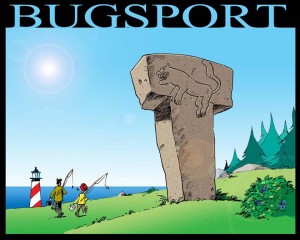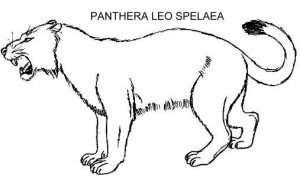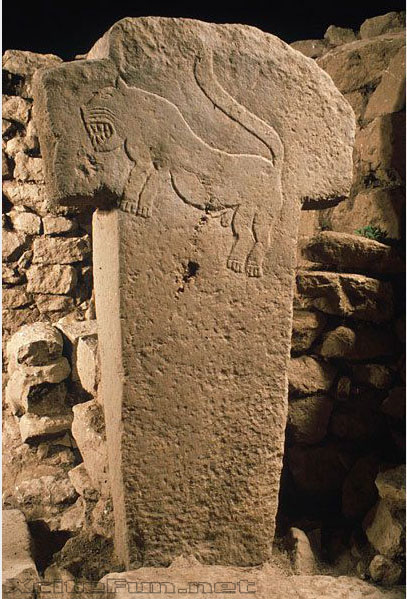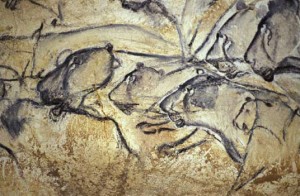
March 22, 2012
Ted Bastien of Bugsport fame has drawn a new illustration that he has given me permission to share here. I found it intriguing because of the subject matter on the stone T-pillar that appears out of nowhere, near the shoreline of Maine.

The illustration shows what resembles an Ice Age lion (Panthera atrox? Panthera leo spelaea?) depicted on a megalithic pillar.

Indeed, I asked Ted about what inspired him, and he said Göbekli Tepe. The artist’s inspiration is a specific Neolithic pillar that does show a probable cave lion at Göbekli Tepe. The location and what various images there make for some interesting reading.

Göbekli Tepe [ɡøbe̞kli te̞pɛ] (“Potbelly Hill”) is a Neolithic (stone-age) hilltop sanctuary erected at the top of a mountain ridge in southeastern Anatolia, some 15 kilometers (9 mi) northeast of the town of Şanlıurfa (formerly Urfa / Edessa). It is the oldest known human-made religious structure. The site was most likely erected by hunter-gatherers in the 10th millennium BCE (c. 12,000 years ago) and has been under excavation since 1994 by German and Turkish archaeologists. Together with Nevalı Çori, it has revolutionized understanding of the Eurasian Neolithic.
Many of the pillars are decorated with carved reliefs of animals and of abstract enigmatic pictograms. The pictograms may represent commonly understood sacred symbols, as known from Neolithic cave paintings elsewhere. The reliefs depict lions, bulls, boars, foxes, gazelles, donkeys, snakes and other reptiles, insects, arachnids, and birds, particularly vultures. (At the time the shrine was constructed, the surrounding country was much lusher and capable of sustaining this variety of wildlife, before millennia of settlement and cultivation resulted in the near–Dust Bowl conditions prevailing today.) Vultures also feature prominently in the iconography of the Neolithic sites of Çatalhöyük and Jericho; it is believed that in the early Neolithic culture of Anatolia and the Near East the deceased were deliberately exposed in order to be excarnated by vultures and other carrion birds. (The head of the deceased was sometimes removed and preserved—possibly a sign of ancestor worship.) This, then, would represent an early form of sky burial, as practiced today by Tibetan Buddhists and by Zoroastrians in India.
Few humanoid figures have surfaced at Göbekli Tepe, but they include the engraving of a naked woman posed frontally in a crouched position that Schmidt likens to the Venus accueillante figures found in Neolithic north Africa, and a decapitated corpse surrounded by vultures in bas-relief. Some of the T-shaped pillars picture human arms, which indicate that they represent the bodies of stylized humans (or anthropomorphic gods). The wider stone member atop the T-shaped pillars is thought to symbolize the head; thus the pillars as a whole have an anthropomorphic identity. One example is decorated with human hands in what could be interpreted as a prayer gesture, with a simple stole or surplice engraved above; this may be intended to signify a temple priest.

About Loren Coleman
Loren Coleman is one of the world’s leading cryptozoologists, some say “the” leading living cryptozoologist. Certainly, he is acknowledged as the current living American researcher and writer who has most popularized cryptozoology in the late 20th and early 21st centuries.
Starting his fieldwork and investigations in 1960, after traveling and trekking extensively in pursuit of cryptozoological mysteries, Coleman began writing to share his experiences in 1969. An honorary member of Ivan T. Sanderson’s Society for the Investigation of the Unexplained in the 1970s, Coleman has been bestowed with similar honorary memberships of the North Idaho College Cryptozoology Club in 1983, and in subsequent years, that of the British Columbia Scientific Cryptozoology Club, CryptoSafari International, and other international organizations. He was also a Life Member and Benefactor of the International Society of Cryptozoology (now-defunct).
Loren Coleman’s daily blog, as a member of the Cryptomundo Team, served as an ongoing avenue of communication for the ever-growing body of cryptozoo news from 2005 through 2013. He returned as an infrequent contributor beginning Halloween week of 2015.
Coleman is the founder in 2003, and current director of the International Cryptozoology Museum in Portland, Maine.
Filed under Alien Big Cats, Artifacts, CryptoZoo News, Extinct, Mystery Cats, Phantom Panthers